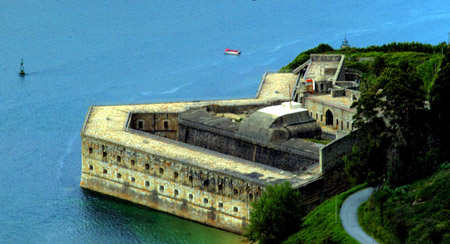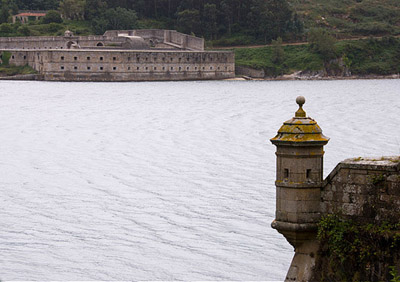 |
Castillo de San Felipe
Ferrol, Spain
|
|
 |
The city of Ferrol, on the northwestern tip of Spain, is one of those places that has a natural harbor, and has thus been inhabited in one way or another since dudes first found they could float things on water that were big enough to carry them places.
Evidence of prehistoric settlements have been found at Ferrol; The Phoenicians set up a "dried and salted cod station" there; The Greeks did Greeky things in the vicinity, and the Romans had a fishing port at Ferrol. The Vandals and then Visigoths took possession of the whole Iberian peninsula after the fall of the Roman Empire in the 5th century, the Muslims crept up Spain starting in the 9th century, and by the 14th century the reconquista had, as its name suggests, reconquested Spain for Christianity.
|
 |
|
|
King Phillip II (1527-1598), recognized Ferrol as an important strategic asset and knew that it was only a matter of time before Britain's Royal Navy (or the French Navy) swooped in to claim the harbor as their own. The King commanded that the entrance to Ferrol Harbor be fortified, and, surprise, the result was named after him.
|
|
 |
The Castillo de San Felipe was built on the northern side of the waterway that leads to the harbor in 1557, and Castillo La Palma was built, around the same time, on the south side. This combination proved effective against all comers, starting in 1594 when the British made their first attempt to take the harbor, and then in 1639 when a French naval force under Admiral Henri d'Escoubleau de Sourdis (1593-1645), who was also the Archbishop of Bordeaux, were both beaten off by the fort of our current interest.
San Felipe's current appearance came about thanks to the Vaubannish aspirations of Spanish engineers between 1731 and 1775.
At the end of the 18th century, France went absolutely crazy. The French Revolution (1789-1799) eventually resulted in some good things (democracy, Napoleon, etc.) and some
|
|
bad things (mass executions, Napoleon, etc.), but at the time it mostly made for lots of European countries frantically hacking at each other.
In 1800, Spain was allied with France in the War of the Second Coalition (1798-1802), against the weird alliance of England, Russia and the Ottoman Empire, among other strange bedfellows. On August 25 a British fleet of 109 ships under the command of Sir Edward Pellew (1757-1833) pounded on the Castillo de San Felipe: Their ultimate intent was to destroy the shipyards at Ferrol. The British also landed around 10,000 troops to take the fort, but San Felipe, La Palma, Spanish gunboats and supporting Spanish troops sent the mighty redcoats off after two days of shooting at each other.
|
British Prime Minister William Pitt (1759-1806), after the failed Ferro Expedition, stated at the House of Commons that, If Great Britain had a naval station so easy to defend as Ferrol, due to its location, it would have been surrounded by a thick silver wall.
Whatever that means.
The French would occupy Ferrol in 1809, assumedly not having had to |
 |
 Castillo La Palma Castillo La Palma |
|
fight their way in this time, but decided it was a dumb thing to do and left after a month.
|
 Good thing these dingleberries are at the corners of San Felipe's bastions. No way the British are getting in with those pointless objects on watch! Good thing these dingleberries are at the corners of San Felipe's bastions. No way the British are getting in with those pointless objects on watch! |
 |
The Castillo la Palma was used as a military prison for officers once seacoast fortifications were rendered obsolete by such inventions as manned flight, but is today abandoned. The Castillo de San Felipe looks to be in good shape these days, and judging by the number of pictures of the interior of the fort that are floating around on Flickr, I'm guessing that it's a popular tourist attraction.
In CS Forrester (1899-1966)'s novel Mr. Midshipman Hornblower (published 1950), fictional Royal Navy hero Horatio Hornblower is imprisoned in a fort at Ferrol for two years after having inadvertantly sailing his ship into the midst of the Spanish Fleet (it was foggy at the time) in 1794. Though the fort in which
|
|
Hornblower and his crew are imprisoned isn't specifically named in the book, it seems quite obvious that Forester was referring to San Felipe. |
|
|
|
|
|
 |




